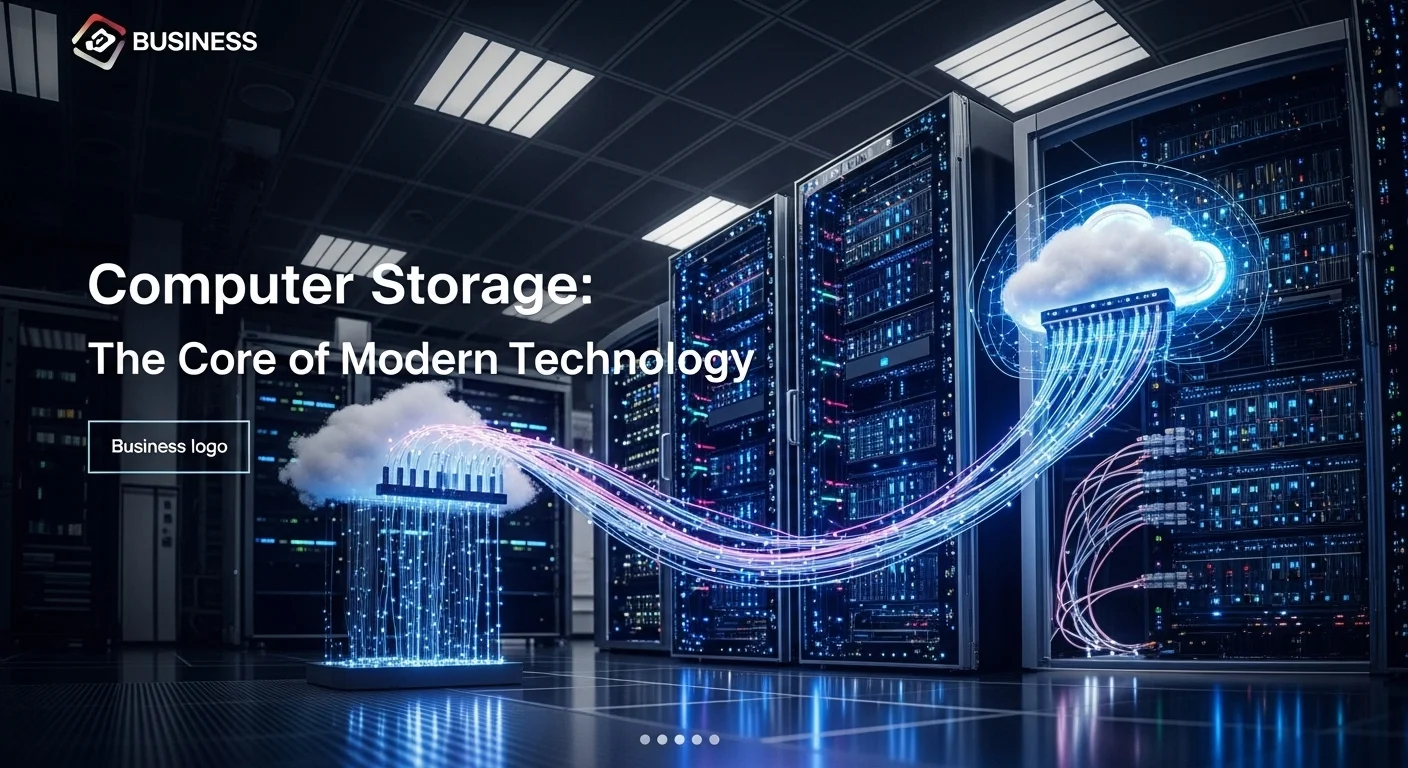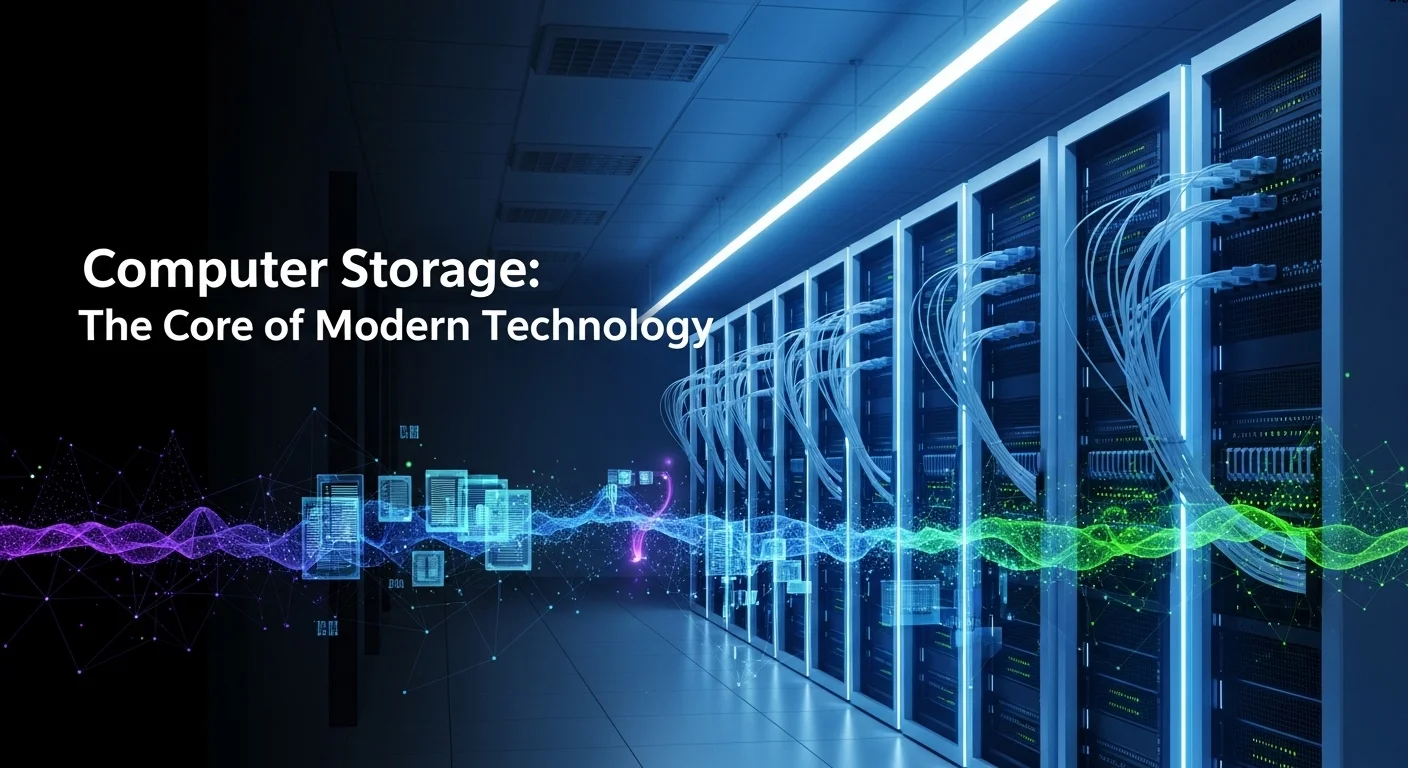Computer Storage: The Core of Modern Technology

Executive Summary
In the digital age, data is the most valuable asset, and at the heart of managing this asset lies computer storage. This article provides a comprehensive exploration of computer storage technology, tracing its evolution from early magnetic tapes to today's high-speed solid-state drives and vast cloud infrastructures. We delve into the critical importance of storage as a fundamental component of all computing, enabling everything from personal device operations to large-scale enterprise applications and advanced AI. The discussion covers various computer storage solutions, including direct-attached (DAS), network-attached (NAS), and storage area networks (SANs), comparing their use cases for different business scales. A significant focus is placed on the transformative impact of the cloud, breaking down concepts like storage as a service in cloud computing, the synergy between compute and storage services, and the revolutionary potential of object storage. Furthermore, we address the paramount concern of data security and storage in cloud computing, offering insights into best practices and modern strategies. This guide is essential for business leaders, IT professionals, and tech enthusiasts seeking to understand and leverage the power of modern storage.
Table of Contents
What is Computer Storage and why is it important in Technology?
In today's hyper-connected world, the term 'data' is ubiquitous, often described as the new oil—a valuable resource that powers the global economy. But what good is oil without a place to store it? This is where computer storage comes in. At its core, computer storage is a technology consisting of computer components and recording media used to retain digital data. It is a fundamental function of any computing device, from the smartphone in your pocket to the massive servers powering the internet. Without storage, every time you turned off your device, all your information—documents, photos, applications, and even the operating system itself—would vanish. The importance of storage technology cannot be overstated; it is the permanent memory of the digital world, the foundation upon which all software, services, and digital experiences are built.
To truly grasp its significance, we must first understand the basic principles. Computer storage is broadly categorized into two types: primary and secondary. Primary storage, commonly known as memory or RAM (Random Access Memory), is volatile. It's incredibly fast and works directly with the computer's processor (CPU) to hold data that is actively being used. Think of it as a workbench where you place the tools and materials you need for an immediate task. However, once the power is cut, the workbench is cleared. Secondary storage, on the other hand, is non-volatile, meaning it retains data even when the power is off. This includes devices like hard disk drives (HDDs), solid-state drives (SSDs), and, by extension, cloud storage. This is your warehouse, where you keep everything for long-term use. The seamless interaction between fast, temporary primary storage and slower, permanent secondary storage is what makes modern computing possible.
The Evolution of Storage: From Punch Cards to the Cloud
The journey of computer storage is a fascinating tale of miniaturization and exponential growth in capacity. The earliest forms of data retention were rudimentary, like punch cards used in the 19th and early 20th centuries, which stored data as a series of holes in stiff paper. The 1950s saw the advent of magnetic storage, with magnetic drums and later, magnetic tapes, which could store significantly more data. The first hard disk drive, the IBM 350, introduced in 1956, was the size of two refrigerators and could store a mere 5 megabytes of data. Compare that to today, where a tiny microSD card can hold over a terabyte of data—a 200,000-fold increase in capacity in a device millions of times smaller.
The 1980s and 1990s were dominated by floppy disks and compact discs (CDs), which made software and data portable for the average consumer. However, the real revolution in personal and enterprise computing came with the refinement of HDDs and the invention of flash-based Solid-State Drives (SSDs). HDDs store data on spinning magnetic platters, while SSDs use flash-memory chips with no moving parts, making them significantly faster, more durable, and more energy-efficient. This leap in performance unlocked new capabilities, from faster boot times to the ability to process vast datasets required for complex applications.
This evolution has now culminated in the era of cloud computing. The physical constraints of local hardware have been transcended by vast, interconnected data centers around the globe. This shift has introduced powerful new concepts and models, fundamentally changing how businesses and individuals approach data. One of the most transformative models is storage as a service in cloud computing (STaaS). STaaS allows organizations to rent storage capacity from a cloud provider instead of purchasing and managing their own infrastructure, converting a large capital expense into a predictable operational cost. This model offers unparalleled scalability, allowing businesses to expand or shrink their storage footprint on demand.
The Symbiotic Relationship Between Compute and Storage
In any technological discussion, especially within cloud computing, it's crucial to understand the relationship between compute and storage. Compute and storage services are the two primary pillars of cloud infrastructure. Compute refers to the processing power (CPU, RAM) needed to run applications and execute tasks. Storage, as we've established, is where the data resides. In the past, these were tightly coupled within a single physical server. However, modern cloud architectures allow for the decoupling of these resources. This means a business can scale its storage capacity independently of its compute power, and vice versa. For example, a company running a large database might need immense storage but relatively modest compute power for certain operations. Decoupling allows them to pay only for the resources they actually need, leading to significant cost optimization and architectural flexibility.
This flexibility is further enhanced by different types of cloud storage designed for specific needs. The three main categories are file, block, and object storage. File storage organizes data in a familiar hierarchical structure of folders and files, ideal for shared document repositories. Block storage breaks data into fixed-size blocks, each with a unique identifier, offering the high performance needed for databases and enterprise applications. A newer and increasingly dominant model is object storage in cloud computing. Object storage manages data as self-contained objects, each comprising the data itself, expandable metadata, and a globally unique ID. Unlike the rigid hierarchy of file storage, object storage uses a flat address space called a bucket. This architecture is massively scalable, making it perfect for storing unstructured data like images, videos, backups, and the vast datasets required for Big Data analytics and Artificial Intelligence. Leading cloud providers like Amazon Web Services (AWS) with S3, Google Cloud with Cloud Storage, and Microsoft Azure with Blob Storage have made object storage a cornerstone of their offerings.
Why Storage is Critical for Modern Business and Technology
The importance of robust computer storage solutions for modern businesses cannot be overstated. Data is the lifeblood of contemporary enterprise, and its proper management is directly linked to operational efficiency, strategic insight, and competitive advantage. Businesses rely on storage for everything: customer relationship management (CRM) systems, financial records, intellectual property, marketing assets, and operational data from IoT devices. A storage failure can lead to catastrophic data loss, crippling downtime, and severe financial and reputational damage.
Furthermore, the rise of data-intensive technologies like AI and machine learning has placed even greater demands on storage systems. Training an AI model requires feeding it colossal amounts of data, which must be stored, accessed, and processed with high speed and reliability. Object storage, with its immense scalability and rich metadata capabilities, is particularly well-suited for these workloads.
With this increasing reliance on data comes the critical challenge of security. As more sensitive information is digitized and stored, it becomes a prime target for cyberattacks. This makes data security and storage in cloud computing a top priority for any organization. Cloud providers invest heavily in securing their infrastructure, but security is a shared responsibility. Businesses must implement their own security measures, including strong encryption for data both at rest (stored on a disk) and in transit (moving across a network), robust access control policies, and regular security audits to protect their digital assets. Choosing a storage solution is no longer just about capacity and speed; it's about building a secure, resilient, and scalable foundation for the future of technology and business.

Complete guide to Computer Storage in Technology and Business Solutions
Navigating the complex landscape of computer storage requires a deep understanding of the available technologies and how they align with specific business needs. From on-premises hardware to sprawling cloud services, the right choice can significantly impact performance, scalability, security, and cost. This guide provides a comprehensive overview of modern computer storage solutions, offering technical descriptions, business applications, and comparative analyses to empower informed decision-making.
On-Premises Storage: Control and Performance
Before the cloud became dominant, all storage was on-premises. While cloud adoption is widespread, on-premises solutions remain relevant and are often essential for specific use cases, particularly where performance, latency, and data sovereignty are critical. There are three primary architectures for on-premises storage.
1. Direct-Attached Storage (DAS)
DAS is the simplest form of storage, where storage devices are connected directly to a single computer or server. This can be an internal hard disk drive (HDD) or solid-state drive (SSD) within a machine, or an external drive connected via USB or Thunderbolt.
Technical Method: The storage device is managed by the host computer's operating system. It offers high-speed data access because there is no network latency. However, its main limitation is that data is not easily shared with other computers and its scalability is limited to the number of drives that can be physically connected to one machine.
Business Application: DAS is ideal for small businesses or individual workstations that require fast, dedicated storage for applications like video editing or scientific computing. It's a cost-effective solution for localized data needs but falls short for collaborative environments.
2. Network-Attached Storage (NAS)
NAS devices are dedicated storage servers that connect to a network, allowing multiple users and devices to access and share data from a central location.
Technical Method: A NAS is essentially a specialized computer with its own lightweight operating system, optimized for file storage and sharing. It connects to the local area network (LAN) via a standard Ethernet cable and serves files using protocols like NFS (Network File System) or SMB/CIFS (Server Message Block/Common Internet File System). Users see the NAS as a shared drive on their network.
Business Application: NAS is extremely popular with small to medium-sized businesses (SMBs) for centralizing file storage, simplifying data backup, and enabling team collaboration. It's relatively easy to set up and manage, offering a good balance of cost, convenience, and scalability for file-based workloads.
3. Storage Area Network (SAN)
A SAN is a high-performance, dedicated network designed to connect servers to storage devices, presenting shared pools of storage as if they were locally attached drives.
Technical Method: Unlike NAS which operates at the file level, SANs operate at the block level. They typically use a high-speed protocol called Fibre Channel, though iSCSI (which runs over standard Ethernet) is a popular alternative. To the server's operating system, the SAN storage appears as a local disk that can be formatted and managed directly. This block-level access provides the high throughput and low latency required for demanding applications.
Business Application: SANs are the domain of large enterprises. They are the backbone for business-critical applications, such as large-scale databases, virtualization environments (like VMware vSphere), and high-transaction-volume e-commerce platforms. While powerful and highly scalable, SANs are complex and expensive to implement and maintain.
The Cloud Revolution: Flexibility and Scale
Cloud storage has fundamentally reshaped the IT landscape by offering virtually limitless capacity on a pay-as-you-go basis. This has democratized access to enterprise-grade infrastructure. Central to this revolution is the concept of storage as a service in cloud computing (STaaS), where a third-party provider manages the underlying hardware and software, freeing businesses from the burden of infrastructure management. Let's explore the primary cloud storage models.
1. File Storage in the Cloud
Cloud-based file storage services (like Amazon EFS or Azure Files) provide a managed version of the NAS experience. They offer fully managed file systems that can be accessed by multiple cloud-based virtual machines or even on-premises servers. This is ideal for applications that rely on a shared file system and need a 'lift-and-shift' migration to the cloud without significant re-architecting.
2. Block Storage in the Cloud
Cloud block storage (like Amazon EBS or Azure Disk Storage) provides persistent block-level storage volumes for use with cloud virtual machines (often called compute instances). These volumes behave like raw, unformatted hard drives. A user can attach a block volume to their virtual server, format it with a file system, and use it for anything from an operating system boot drive to a high-performance database. The performance of these volumes can often be provisioned, allowing users to pay for the specific IOPS (Input/Output Operations Per Second) they require, making it a core component of many compute and storage services.
3. Object Storage in the Cloud: The Modern Standard
As discussed previously, object storage in cloud computing has become the de facto standard for modern, cloud-native applications due to its incredible scalability, durability, and cost-effectiveness.
Technical Method: Data is stored as objects in a flat namespace called a bucket. Each object contains the data, a rich set of metadata, and a unique ID. Access is typically handled via a RESTful API over HTTP. This API-driven approach makes it incredibly versatile and easy to integrate with applications. Object storage systems are designed for extreme durability by automatically replicating data across multiple devices and even geographic regions.
Business Techniques and Applications: The use cases for object storage are vast and growing. It is the preferred solution for:
- Backup and Archiving: Its low cost and high durability make it perfect for long-term data retention and disaster recovery.
- Big Data and Data Lakes: Object storage can hold petabytes or even exabytes of unstructured data, forming the foundation of a data lake where businesses can run analytics, machine learning, and AI workloads.
- Cloud-Native Applications: Modern applications, especially those built on microservices architectures, use object storage to store and share state, logs, and other data.
- Content Delivery: It is often used as the origin for Content Delivery Networks (CDNs) to distribute static assets like images, videos, and software downloads globally with low latency.
Ensuring Security: A Critical Pillar of Storage Strategy
Whether on-premises or in the cloud, data security is non-negotiable. However, the cloud introduces a unique dynamic known as the 'Shared Responsibility Model'. The cloud provider is responsible for the 'security *of* the cloud' (protecting the physical infrastructure), while the customer is responsible for 'security *in* the cloud' (protecting their own data and applications). Mastering data security and storage in cloud computing involves several key practices:
- Encryption: Data must be encrypted both *at rest* (while stored) and *in transit* (while moving over the network). All major cloud providers offer robust encryption features, often enabled by default.
- Identity and Access Management (IAM): IAM policies are used to enforce the principle of least privilege, ensuring that users and applications only have access to the specific data they absolutely need. Multi-factor authentication (MFA) should be enforced for all user accounts.
- Network Security: Virtual Private Clouds (VPCs) and network access control lists can be used to create logically isolated environments, preventing unauthorized network access to storage resources.
- Auditing and Monitoring: Continuously logging and monitoring access to data is crucial for detecting and responding to suspicious activity. Tools that provide visibility into who is accessing what data, and when, are essential for a strong security posture.
- Compliance: Businesses in regulated industries (like healthcare with HIPAA or finance with PCI DSS) must ensure their storage solution meets specific compliance standards. Reputable cloud providers offer services and documentation to help customers achieve and maintain compliance.
Comparison and Conclusion: Building the Right Strategy
Choosing the right storage solution is not a matter of 'on-premises vs. cloud' but rather of creating a holistic strategy that leverages the best of all worlds. Many businesses today adopt a hybrid cloud approach, keeping highly sensitive or performance-critical data on-premises (perhaps on a SAN) while using the cloud for scalable backups, analytics, and application development.
Here's a simplified comparison:
- For small businesses needing simple file sharing: A NAS device is often the perfect starting point.
- For enterprises with high-performance database needs: A SAN on-premises or high-performance block storage in the cloud is necessary.
- For storing vast amounts of unstructured data for analytics or backup: Object storage in cloud computing is the undisputed leader.
- For organizations seeking to minimize capital expenditure and maximize flexibility: A cloud-first strategy leveraging storage as a service in cloud computing is the most effective path.
Ultimately, a modern storage strategy is dynamic. It understands the distinct roles of different computer storage solutions and combines them to create a secure, scalable, and cost-effective data infrastructure. It recognizes the tight integration of compute and storage services and prioritizes robust data security and storage in cloud computing to protect the organization's most valuable asset.

Tips and strategies for Computer Storage to improve your Technology experience
In the modern digital ecosystem, effective storage management is no longer just an IT department concern; it's a critical business function that impacts everything from daily productivity to long-term strategic success. Optimizing your storage infrastructure, whether for personal use or for a multinational corporation, involves a combination of best practices, smart strategies, and leveraging the right tools. This section provides actionable tips and forward-looking strategies to enhance your technology experience through superior computer storage management, with a keen focus on cloud-centric approaches and data security.
Best Practices for Foundational Storage Management
Before diving into advanced strategies, it's essential to master the fundamentals. These practices apply universally, regardless of the scale or type of storage system you use.
Implement the 3-2-1 Backup Rule: This is the gold standard for data protection. It dictates that you should have at least three total copies of your data, two of which are on different types of media, and at least one copy stored off-site. For example, you could have the original data on your server's internal drive (Copy 1), a local backup on a NAS device (Copy 2, different media), and a third copy in the cloud (Copy 3, off-site). This strategy provides robust protection against almost any failure scenario, from hardware malfunction to a natural disaster.
Practice Data Hygiene and Tiering: Not all data is created equal. Regularly audit your data to identify what is critical ('hot'), what is accessed infrequently ('warm'), and what is purely for archival purposes ('cold'). This process, known as data tiering, allows you to move less critical data to cheaper, slower storage. For instance, within an object storage in cloud computing service like Amazon S3, you can create lifecycle policies that automatically transition data from the standard, high-performance tier to an infrequent access tier, and finally to a deep archive tier like Glacier, dramatically reducing costs without manual intervention.
Embrace Automation: Manual storage management is prone to error and inefficiency. Use automation for tasks like backups, data tiering, and security monitoring. Scripting or using built-in features of your storage platform can ensure that critical tasks are performed consistently and reliably. AI-powered tools are also emerging to automate and optimize storage performance and resource allocation, a trend expected to grow significantly.
Regularly Test Your Recovery Plan: A backup is useless if it can't be restored. Periodically conduct disaster recovery drills to ensure your backup and restore processes work as expected. This practice helps identify weaknesses in your strategy before a real crisis occurs and ensures your team is prepared to act swiftly, minimizing downtime.
Advanced Strategies for Cloud and Hybrid Environments
As businesses increasingly rely on the cloud, their storage strategies must evolve. Leveraging the full potential of cloud services requires a more sophisticated approach than simply treating the cloud as a remote hard drive.
Optimizing Costs in the Cloud
The pay-as-you-go model of cloud storage is a double-edged sword. While it offers flexibility, unmanaged usage can lead to spiraling costs. A key strategy is to deeply understand and utilize the tools provided by cloud vendors. When utilizing storage as a service in cloud computing, actively monitor your usage with tools like AWS Cost Explorer or Azure Cost Management. Set up billing alerts to be notified of unexpected spikes in spending. Critically analyze which storage class is appropriate for each dataset. Using a high-performance block storage volume for data that is rarely accessed is a common and costly mistake. For many modern applications, shifting from block or file storage to object storage in cloud computing can yield substantial savings, especially for unstructured data.
Decoupling Compute and Storage for Maximum Efficiency
One of the most powerful architectural patterns in the cloud is the separation of compute and storage. Modern data platforms like Snowflake and Databricks are built on this principle. They use scalable compute and storage services independently. An analytics query can spin up a massive compute cluster to process data stored in a central object storage repository, and then shut down the compute cluster once the job is done, while the data remains persistent and cheaply stored. This approach offers incredible elasticity and cost-efficiency. Businesses should design their applications to leverage this decoupling, avoiding monolithic architectures where compute and storage resources must be scaled together, which often leads to over-provisioning and wasted resources.
Building a Resilient Hybrid Cloud Strategy
A hybrid cloud strategy combines on-premises infrastructure with public cloud services, aiming to get the best of both worlds. For example, a business might use an on-premises SAN for its latency-sensitive production database while using the cloud for development, testing, and disaster recovery. Tools like AWS Storage Gateway or Azure Arc allow for seamless integration, creating a unified data fabric across environments. This approach allows businesses to maintain control over critical data while leveraging the scale and innovation of the public cloud. Effective hybrid strategies are crucial for data migration, providing a phased approach to moving workloads to the cloud without a disruptive 'big bang' cutover.
Fortifying Security: A Proactive Approach
In an era of constant cyber threats, a reactive security posture is a recipe for disaster. A proactive strategy for data security and storage in cloud computing is essential.
Adopt a Zero-Trust Architecture: The traditional 'castle-and-moat' security model is obsolete. A Zero-Trust model assumes that threats can exist both outside and inside the network. It operates on the principle of 'never trust, always verify'. In practice, this means strictly enforcing identity verification for every person and device trying to access resources, implementing micro-segmentation to limit lateral movement within the network, and applying the principle of least privilege to all access controls.
Leverage Immutability for Ransomware Protection: Ransomware is one of the biggest threats to data storage. A powerful defense is to use immutable storage, where data, once written, cannot be altered or deleted for a specified period. Many object storage in cloud computing platforms offer features like 'Object Lock' or 'Immutability Policies'. If a ransomware attack occurs, you can restore your systems from these clean, unchangeable backup copies, rendering the attack ineffective.
Continuous Security Posture Management: The cloud environment is dynamic. New resources are spun up and down constantly, creating potential security gaps. Use Cloud Security Posture Management (CSPM) tools to continuously scan your environment for misconfigurations, such as public-facing storage buckets or overly permissive IAM roles. These tools provide automated alerts and remediation steps, helping to maintain a strong security posture in real-time.
Looking to the Future: Emerging Storage Technologies
The innovation in computer storage is relentless. Businesses should keep an eye on emerging trends that will shape the future. Technologies like DNA data storage and 5D optical storage promise incredible density and longevity, though they are still in the research phase. More immediately, computational storage—drives that can process data directly on the device—is set to reduce data movement and accelerate analytics. As a quality external resource, organizations can explore the whitepapers and technical documentation from the Storage Networking Industry Association (SNIA), which provides deep insights into these evolving standards and technologies.
By combining foundational best practices with advanced cloud-native strategies and a forward-looking perspective, individuals and businesses can transform their computer storage solutions from a mere utility into a powerful engine for innovation, efficiency, and security.
Expert Reviews & Testimonials
Sarah Johnson, Business Owner ⭐⭐⭐
The information about Computer Storage is correct but I think they could add more practical examples for business owners like us.
Mike Chen, IT Consultant ⭐⭐⭐⭐
Useful article about Computer Storage. It helped me better understand the topic, although some concepts could be explained more simply.
Emma Davis, Tech Expert ⭐⭐⭐⭐⭐
Excellent article! Very comprehensive on Computer Storage. It helped me a lot for my specialization and I understood everything perfectly.



